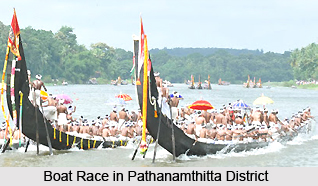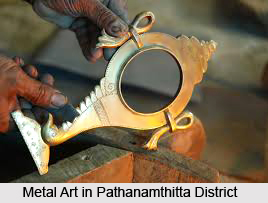 Culture of Pathanamthitta district has been seen to follow a rich tradition. The culture of a place is contained in the art, architecture, music, sculpture, literary and various other art forms that have been preserved and handed down through generations. Though Pathanamthitta is one of the newest districts in the state of Kerala, it has its own unique cultural identity, rich in art and culture. The rich art includes the famous folk called Padayani. Vasthuvidya Gurukulam, constituted by the State`s Cultural Department is a unique institution functioning for the promotion of Vasthuvidya. Discussed below are the various art forms typical to the district.
Culture of Pathanamthitta district has been seen to follow a rich tradition. The culture of a place is contained in the art, architecture, music, sculpture, literary and various other art forms that have been preserved and handed down through generations. Though Pathanamthitta is one of the newest districts in the state of Kerala, it has its own unique cultural identity, rich in art and culture. The rich art includes the famous folk called Padayani. Vasthuvidya Gurukulam, constituted by the State`s Cultural Department is a unique institution functioning for the promotion of Vasthuvidya. Discussed below are the various art forms typical to the district.
Aranmula Kannadi
One of the most unique art forms native to the Pathanamthitta district is that of Aranmula Kannadi. Aranmula Kannadi literally means metal mirror. The process of making the metal mirror is a long process that requires a lot of patience. The technique of production of this mirror is a closely guarded secret handed over from generation to generation of craftsmen. Some metals, still undisclosed, are alloyed with copper and tin to cast the Aranmula Kannadi in typical clay moulds. It takes around 14 days to make a dozen metal mirrors. The smallest of the Aranmula Kannadi is of one and a half inches.
Padayani
The Padayani dance performances are ten day long performances held as part of the annual festival of the Kadamanitta Devi Temple. It is a ritualistic dance, and the term Padayani literally means an array of common people. The dance form of the Padayani is associated with the Devi (goddess) temples of Central Travancore area. At least in a dozen village temples the art finds its existence, with the active co-operation of the villagers who share the ritual experience and the responsibilities.
 There are various figures in the Padayani, such as Pisachu, Kali, Karakkura, Pillatini, Bhairavi, Kalan etc. The dancers and performers wear masks which are painted in a grotesque touch. The round eyes and the triangular ears and abnormal size of the head gear give a touch of super human dimension. The Mannan (village washerman) who is also in charge of plucking coconuts supplies the areca sheaths and other materials with which the masks are made. The Kaniyan paints the masks.
There are various figures in the Padayani, such as Pisachu, Kali, Karakkura, Pillatini, Bhairavi, Kalan etc. The dancers and performers wear masks which are painted in a grotesque touch. The round eyes and the triangular ears and abnormal size of the head gear give a touch of super human dimension. The Mannan (village washerman) who is also in charge of plucking coconuts supplies the areca sheaths and other materials with which the masks are made. The Kaniyan paints the masks.
The process of the Padayani is as follows. Velan (the sorcerer) plays on his percussion instrument `Para` when the areca tree is uprooted and ceremoniously placed at the temple premises as the flagstaff of the festival for 28 days which has to conclude on the `Bharani` day in the month of Meenam. The `Velichappadu` who is from the Nayar caste gets possessed and dances to the rhythm of the Para and officiates the ritual of uprooting and placing the flagstaff with the help of the villagers. On the next day of the flag hosting ceremony, the villagers assemble in the temple around 10 in the night with lighted torches and go thrice around the shrine articulating meaningless syllables meant for invoking the subordinate spirits who pay homage to the main deity. This is technically called `Chuttupatayani` or Patayani with torches. This process continues for 18 days. On the 19th day the villagers reach the temple in a procession singing boat songs in group in a rhythm peculiar to the rowing of a country boat. In front of the temple before a lighted lamp the neighbouring villagers conduct a group dance called `Kappoli` as a gesture of co-operation with the celebrations. In dancing they show a number of acrobatic martial feats accompanied by singing. The first item proper in the series is `Tavati` in which six to seven experts dance to the basic rhythms of Patayani to the accompaniment of the drum called `Tappu` a round wooden instrument covered with thick hide.
Vasthuvidya Gurukulam
Vasthuvidya Gurukulam is a unique institution that has been formed by the state Cultural Department for the promotion of ancient Indian architecture. Ancient Indian architecture is believed to be the purest and most original expression of ancient Indian socio-cultural heritage. The main intent of the Gurukulam is the preservation and promotion of vasthuvidya and mural paintings. It also aims at the renovation and conservation of traditional buildings and mural paintings.As part of its efforts towards the promotion of Vasthuvidya, the Gurukulum conducts a one year post graduate diploma course in Vasthuvidya. Apart from this, it also conducts a four month training course in the application of principles and practices of Vasthuvidya for the craftsmen belonging to the community of carpenters engaged in the building industry. A total of four academic courses are conducted based on the texts of the Vasthuvidya.
 One of them is also approved by the Mahatma Gandhi University. For those interested in building constructions in the traditional architectural patterns, Gurukulum has a very efficient consultancy center which prepares sketches and plans and designs building.
One of them is also approved by the Mahatma Gandhi University. For those interested in building constructions in the traditional architectural patterns, Gurukulum has a very efficient consultancy center which prepares sketches and plans and designs building.
There is a mural art gallery located here which has been designed to educate the people and impart information on the complex art form of mural painting. Mural paintings drawn with natural colours with complex techniques are used and exhibited here.
It is therefore evident from the above discussion that the Pathanamthitta district has a rich tradition in the cultural field.



















